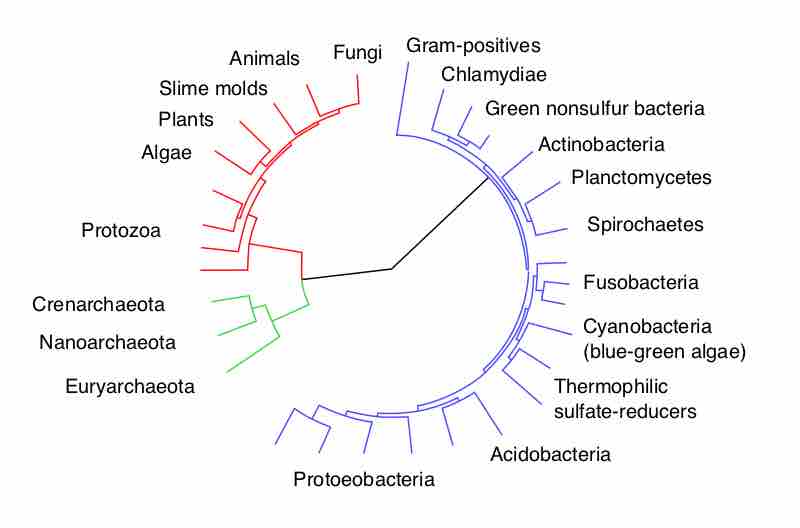Genomic Similarities Between Distant Species
Genetic distance refers to the genetic divergence between species or between populations within a species. Smaller genetic distances indicate that the populations have more similar genes, which indicates they are closely related; they have a recent common ancestor, or recent interbreeding has taken place. Genetic distance is useful in reconstructing the history of populations. For example, evidence from genetic distance suggests that humans arrived in America about 30,000 years ago. By examining the difference between allele frequencies between the populations, genetic distance can estimate how long ago the two populations were together.
Phylogenetic Relationships
Phylogeny describes the relationships of an organism, such as the relationship with its ancestors and the species it is most closely related. Phylogenetic relationships provide information on shared ancestry but not necessarily on how organisms are similar or different. The use of advanced genomic analysis has allowed us to establish phylogenetic trees, which map the relationship between species at a genetic and molecular level. The ability to use these technologies has established previously unknown relationships and has contributed to a more complex evolutionary history. These technologies have established genomic similarities between distant species by establishing genetic distances . In addition, the mechanisms by which genomic similarities between distant species occur can include horizontal gene transfer.

Tree of Life
Diagrammatic representation of the divergence of modern taxonomic groups from their common ancestor. This shows the genomic similarities that can exist between distant species based on their relationship with this ancestor.
Horizontal Gene Transfer
Horizontal gene transfer (HGT), also known as lateral gene transfer, is the transfer of genes between unrelated species. Genes have been shown to be passed between species which are only distantly related using standard phylogeny, thus adding a layer of complexity to the understanding of phylogenetic relationships. The various ways that HGT occurs in prokaryotes is important to understanding phylogenies. Although at present, HGT is not viewed as important to eukaryotic evolution, HGT does occur in this domain as well. Finally, as an example of the ultimate gene transfer, theories of genome fusion between symbiotic or endosymbiotic organisms have been proposed to explain an event of great importance—the evolution of the first eukaryotic cell, without which humans could not have come into existence.
The mechanism of HGT has been shown to be quite common in the prokaryotic domains of Bacteria and Archaea, significantly changing the way their evolution is viewed. The majority of evolutionary models, such as in the endosymbiont theory, propose that eukaryotes descended from multiple prokaryotes, which makes HGT all the more important to understanding the phylogenetic relationships of all extant and extinct species. These gene transfers between species are the major mechanism whereby bacteria acquire resistance to antibiotics. Classically, this type of transfer has been thought to occur by three different mechanisms: transformation, transduction and conjugation.
Although it is easy to see how prokaryotes exchange genetic material by HGT, it was initially thought that this process was absent in eukaryotes, followed by the idea that the gene transfers between multicellular eukaryotes should be more difficult. In spite of this fact, HGT between distantly related organisms has been demonstrated in several eukaryotic species.
In animals, a particularly interesting example of HGT occurs within the aphid species. Aphids are insects that vary in color based on carotenoid content. Carotenoids are pigments made by a variety of plants, fungi, and microbes, and they serve a variety of functions in animals, who obtain these chemicals from their food. Humans require carotenoids to synthesize vitamin A, and we obtain them by eating orange fruits and vegetables: carrots, apricots, mangoes, and sweet potatoes. On the other hand, aphids have acquired the ability to make the carotenoids on their own. According to DNA analysis, this ability is due to the transfer of fungal genes into the insect by HGT, presumably as the insect consumed fungi for food .
Horizontal Gene Transfer in Animals
(a) Red aphids get their color from red carotenoid pigment. Genes necessary to make this pigment are present in certain fungi, and scientists speculate that aphids acquired these genes through HGT after consuming fungi for food. If genes for making carotenoids are inactivated by mutation, the aphids revert back to (b) their green color. Red coloration makes the aphids a lot more conspicuous to predators, but evidence suggests that red aphids are more resistant to insecticides than green ones. Thus, red aphids may be more fit to survive in some environments than green ones.